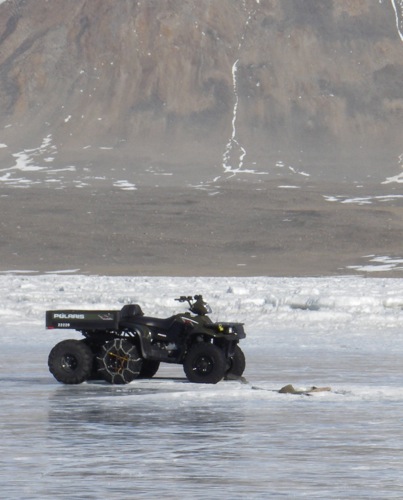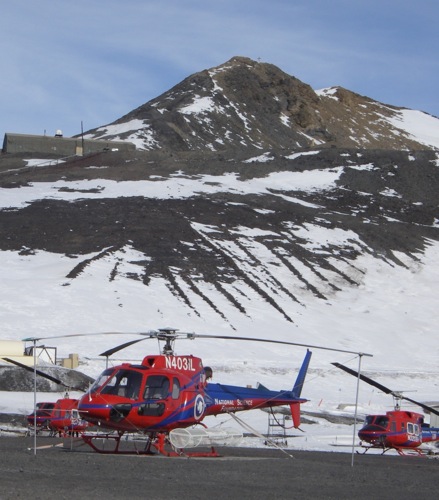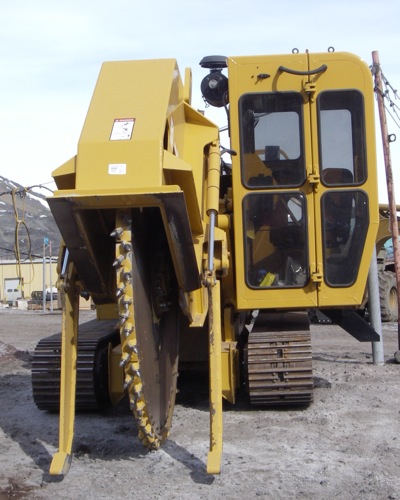The beautiful snow McMurdo is blanketed by has forced the DOM team into a couple days of quiet time- a chance to tie up loose ends with some data collection, begin to clean and box up the lab for the winter, organize samples, and rest. It is a well-deserved couple of days as Collin, Mike, and Heidi wait for the snow to stop falling long enough for them to take a helicopter out to the Cotton Glacier for the final sampling trip of the season. I used this time to answer quite a few very wonderful questions sent to the Ask the Team section of this PolarTREC site. Thanks to all of you who shared their curiosity with the rest of the Polar Enthusiasts! One of the questions I received asked about the shape of the Weddell Seals teeth and how it helped them chew through the sea ice to maintain openings to haul out from. I found great examples today to illustrate the shape of the teeth and thought I would share them in this journal as an additional enticement to get more of you to send questions to the Ask the Team section of the DOM site. The canine and incisor teeth of the Weddell Seals are pointed forward, unlike our canines and incisors, which are typically straight up and down. This adaptation in the Weddell is amazing in many ways- can you imagine how useful it is to have "digging" teeth, but it is also detrimental to the longevity of the seal. Their teeth wear down over the years until they are no longer able to dig and must find holes carved out by others when they can. Living off the support of other Weddell Seals does not always work, and older seals with worn down teeth pass away, sometimes long before the average life expectancy is met. In the foyer of the Crary Science Building we have cases filled with Antarctic artifacts, some of which are skulls of Antarctic marine mammals, including a couple of Weddell Seals. Compare the teeth of the Weddell Seal to that of another Antarctic seal, the Leopard Seal.
 The incisors and canines point slightly forward to aid the seal in chewing through the sea ice.
The incisors and canines point slightly forward to aid the seal in chewing through the sea ice.
 The teeth of the Leopard Seal are not used to chew through the ice, but do help them in hunting and killing their prey, which includes penguins.
The teeth of the Leopard Seal are not used to chew through the ice, but do help them in hunting and killing their prey, which includes penguins.
 This skull of this seal, a little older than 20 years when it passed away, shows dramatic wearing of the "digging" teeth.
This skull of this seal, a little older than 20 years when it passed away, shows dramatic wearing of the "digging" teeth.
The rest of this journal is for all of you who were fascinated by "big trucks" as a child, or maybe even as an adult- just a smattering of the forms of transportation we have in and around Antarctica. There are trucks, bulldozers, ice-saw rigs, old-fashioned, but still essential, sledges, and planes, but no typical automobiles like you find throughout the rest of the world. Around McMurdo the beeps, honks, rumbles, and growls of these machines are the background noise to this hustling and bustling research station.
 Great to load up with gear and pull behind a snowmachine or ATV. The deisgn has not changed much in the last 100 years.
Great to load up with gear and pull behind a snowmachine or ATV. The deisgn has not changed much in the last 100 years.
 A SNOWMACHINE! (The difference is only in the name.)
A SNOWMACHINE! (The difference is only in the name.)
 The DOM team used this ATV to get around on Lake Fryxell- we drove on the frozen lake!
The DOM team used this ATV to get around on Lake Fryxell- we drove on the frozen lake!
 The skiff we eventually used to cross the moat that formed around Lake Fryxell in the summer.
The skiff we eventually used to cross the moat that formed around Lake Fryxell in the summer.
 The military cargo plane that whisked me off to Antarctica.
The military cargo plane that whisked me off to Antarctica.
 Helicopters travel long distances, carry a good amount of equipment, and are able to touch down at sites planes cannot.
Helicopters travel long distances, carry a good amount of equipment, and are able to touch down at sites planes cannot.
 We have a fabulous fire squad in McMurdo that does more than just fight fires.
We have a fabulous fire squad in McMurdo that does more than just fight fires.
 This rig saws though the ice- pretty amazing!
This rig saws though the ice- pretty amazing!
 A bit of a slow ride, but one of the most widely used people transporters when traveling on the ice.
A bit of a slow ride, but one of the most widely used people transporters when traveling on the ice.
 Trucks with this type of tires drive over ice and through snow much better than normal truck tires.
Trucks with this type of tires drive over ice and through snow much better than normal truck tires.
 The infamous Terra Bus
The infamous Terra Bus
 The tires on Ivan are almost as tall as I am! (I am 5'3")
The tires on Ivan are almost as tall as I am! (I am 5'3")
 Heavy Machine Operators love to name their rigs.
Heavy Machine Operators love to name their rigs.
 The bulldozer
The bulldozer
 My feet are still the mode of transportation I use most often.
My feet are still the mode of transportation I use most often.

